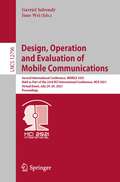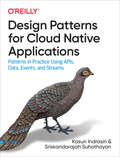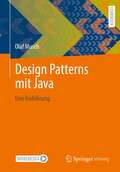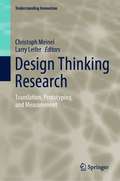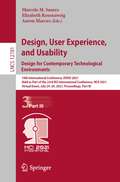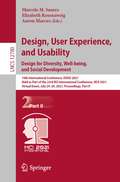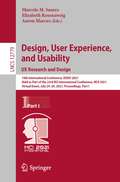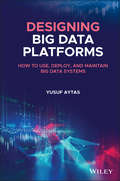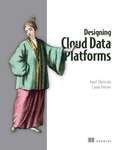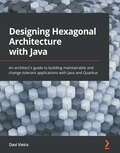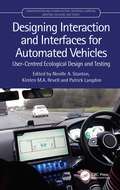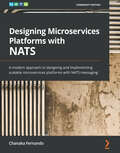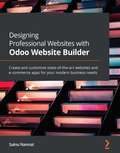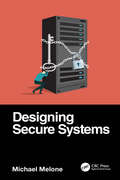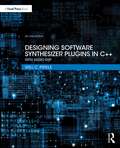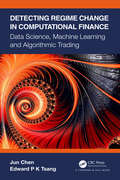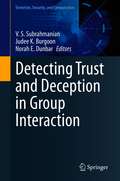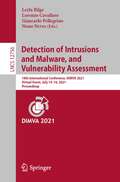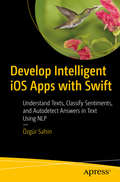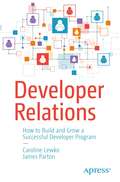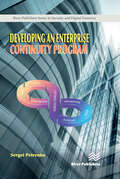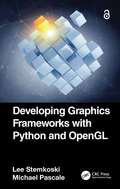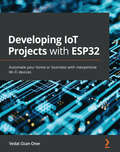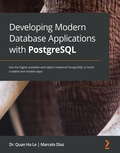- Table View
- List View
Design, Operation and Evaluation of Mobile Communications: Second International Conference, MOBILE 2021, Held as Part of the 23rd HCI International Conference, HCII 2021, Virtual Event, July 24–29, 2021, Proceedings (Lecture Notes in Computer Science #12796)
by Gavriel Salvendy June WeiThis conference proceeding LNCS 12796 constitutes the thoroughly refereed proceedings of the 1th International Conference on Cross-Cultural Design, CCD 2019, which was held as part of the 23rd HCI International Conference, HCII 2021 as a virtual event, due to COVID-19, in July 2021.The total of 1276 papers and 241 posters included in the 39 HCII 2021 proceedings volumes were carefully reviewed and selected from 5222 submissions. MOBILE 2021 includes a total of 27 papers; they were organized in topical sections named: Designing, Developing and Evaluating Mobile Interaction Systems and User Experience, Acceptance and Impact of Mobile Communications.
Design Patterns for Cloud Native Applications
by Kasun Indrasiri Sriskandarajah SuhothayanWith the immense cost savings and scalability the cloud provides, the rationale for building cloud native applications is no longer in question. The real issue is how. With this practical guide, developers will learn about the most commonly used design patterns for building cloud native applications using APIs, data, events, and streams in both greenfield and brownfield development.You'll learn how to incrementally design, develop, and deploy large and effective cloud native applications that you can manage and maintain at scale with minimal cost, time, and effort. Authors Kasun Indrasiri and Sriskandarajah Suhothayan highlight use cases that effectively demonstrate the challenges you might encounter at each step.Learn the fundamentals of cloud native applicationsExplore key cloud native communication, connectivity, and composition patternsLearn decentralized data management techniquesUse event-driven architecture to build distributed and scalable cloud native applicationsExplore the most commonly used patterns for API management and consumptionExamine some of the tools and technologies you'll need for building cloud native systems
Design Patterns mit Java: Eine Einführung
by Olaf MuschEine praxisnahe Beschreibung der Software Design Patterns, wie sie im 1994 erschienen Buch „Design Patterns – Elements of Reusable Object-Oriented Software“ der Autorengruppe Gamma, Helm, Johnson und Vlissides (auch genannt „Gang of Four“, kurz GoF, also „Viererbande“) Erwähnung finden.Alle Muster werden anhand von Beispielen detailliert erläutert und auch kritisch gewürdigt. Darüber hinaus werden Entwurfsprinzipien der objektorientierten Programmierung beschrieben und berücksichtigt. Alle Beispiele sind ausführlich im Quellcode kommentiert und unter Java 16 lauffähig. Teilweise werden auch neuere Features von Java bis einschließlich Version 16 erläutert und verwendet.
Design Thinking Research: Translation, Prototyping, and Measurement (Understanding Innovation)
by Christoph Meinel Larry LeiferExtensive research conducted by the Hasso Plattner Design Thinking Research Program at Stanford University in Palo Alto, California, USA, and the Hasso Plattner Institute in Potsdam, Germany, has yielded valuable insights on why and how design thinking works. The participating researchers have identified metrics, developed models, and conducted studies, which are featured in this book, and in the previous volumes of this series. This volume provides readers with tools to bridge the gap between research and practice in design thinking with varied real world examples. Several different approaches to design thinking are presented in this volume. Acquired frameworks are leveraged to understand design thinking team dynamics. The contributing authors lead the reader through new approaches and application fields and show that design thinking can tap the potential of digital technologies in a human-centered way. In a final section, new ideas in neurodesign at Stanford University and at Hasso Plattner Institute in Potsdam are elaborated upon thereby challenging the reader to consider newly developed methodologies and provide discussion of how these insights can be applied to various sectors. Special emphasis is placed on understanding the mechanisms underlying design thinking at the individual and team levels. Design thinking can be learned. It has a methodology that can be observed across multiple settings and accordingly, the reader can adopt new frameworks to modify and update existing practice. The research outcomes compiled in this book are intended to inform and provide inspiration for all those seeking to drive innovation – be they experienced design thinkers or newcomers.
Design, User Experience, and Usability: 10th International Conference, DUXU 2021, Held as Part of the 23rd HCI International Conference, HCII 2021, Virtual Event, July 24–29, 2021, Proceedings, Part III (Lecture Notes in Computer Science #12781)
by Marcelo M. Soares Elizabeth Rosenzweig Aaron MarcusThis three volume set LNCS 12779, 12780, and 12781 constitutes the refereed proceedings of the 10th International Conference on Design, User Experience, and Usability, DUXU 2021, held as part of the 23rd International Conference, HCI International 2021, which took place in July 2021. Due to COVID-19 pandemic the conference was held virtually. The total of 1276 papers and 241 poster papers included in the 39 HCII 2021 proceedings volumes was carefully reviewed and selected from 5222 submissions. The regular papers of DUXU 2021 are organized in topical sections named: Mobile UX Research and Design; DUXU for Extended Reality; DUXU for the Creative Industries; Usability and UX Studies.
Design, User Experience, and Usability: 10th International Conference, DUXU 2021, Held as Part of the 23rd HCI International Conference, HCII 2021, Virtual Event, July 24–29, 2021, Proceedings, Part II (Lecture Notes in Computer Science #12780)
by Marcelo M. Soares Elizabeth Rosenzweig Aaron MarcusThis three volume set LNCS 12779, 12780, and 12781 constitutes the refereed proceedings of the 10th International Conference on Design, User Experience, and Usability, DUXU 2021, held as part of the 23rd International Conference, HCI International 2021, which took place in July 2021. Due to COVID-19 pandemic the conference was held virtually. The total of 1276 papers and 241 poster papers included in the 39 HCII 2021 proceedings volumes was carefully reviewed and selected from 5222 submissions. The regular papers of DUXU 2021 are organized in topical sections named: Experience Design across Cultures; Design for Inclusion and Social Development¸ Design for Health and Well-being; DUXU Case Studies.
Design, User Experience, and Usability: 10th International Conference, DUXU 2021, Held as Part of the 23rd HCI International Conference, HCII 2021, Virtual Event, July 24–29, 2021, Proceedings, Part I (Lecture Notes in Computer Science #12779)
by Marcelo M. Soares Elizabeth Rosenzweig Aaron MarcusThis three volume set LNCS 12779, 12780, and 12781 constitutes the refereed proceedings of the 10th International Conference on Design, User Experience, and Usability, DUXU 2021, held as part of the 23rd International Conference, HCI International 2021, which took place in July 2021. Due to COVID-19 pandemic the conference was held virtually.The total of 1276 papers and 241 poster papers included in the 39 HCII 2021 proceedings volumes was carefully reviewed and selected from 5222 submissions. The regular papers of DUXU 2021 are organized in topical sections named: UX Design Methods and Techniques; Methods and Techniques for UX Research; Visual Languages and Information Visualization; Design Education and Practice.
Designing Big Data Platforms: How to Use, Deploy, and Maintain Big Data Systems
by Yusuf AytasDESIGNING BIG DATA PLATFORMS Provides expert guidance and valuable insights on getting the most out of Big Data systemsAn array of tools are currently available for managing and processing data—some are ready-to-go solutions that can be immediately deployed, while others require complex and time-intensive setups. With such a vast range of options, choosing the right tool to build a solution can be complicated, as can determining which tools work well with each other. Designing Big Data Platforms provides clear and authoritative guidance on the critical decisions necessary for successfully deploying, operating, and maintaining Big Data systems.This highly practical guide helps readers understand how to process large amounts of data with well-known Linux tools and database solutions, use effective techniques to collect and manage data from multiple sources, transform data into meaningful business insights, and much more. Author Yusuf Aytas, a software engineer with a vast amount of big data experience, discusses the design of the ideal Big Data platform: one that meets the needs of data analysts, data engineers, data scientists, software engineers, and a spectrum of other stakeholders across an organization. Detailed yet accessible chapters cover key topics such as stream data processing, data analytics, data science, data discovery, and data security. This real-world manual for Big Data technologies:Provides up-to-date coverage of the tools currently used in Big Data processing and managementOffers step-by-step guidance on building a data pipeline, from basic scripting to distributed systemsHighlights and explains how data is processed at scaleIncludes an introduction to the foundation of a modern data platformDesigning Big Data Platforms: How to Use, Deploy, and Maintain Big Data Systems is a must-have for all professionals working with Big Data, as well researchers and students in computer science and related fields.
Designing Cloud Data Platforms
by Danil Zburivsky Lynda PartnerIn Designing Cloud Data Platforms, Danil Zburivsky and Lynda Partner reveal a six-layer approach that increases flexibility and reduces costs. Discover patterns for ingesting data from a variety of sources, then learn to harness pre-built services provided by cloud vendors.Summary Centralized data warehouses, the long-time defacto standard for housing data for analytics, are rapidly giving way to multi-faceted cloud data platforms. Companies that embrace modern cloud data platforms benefit from an integrated view of their business using all of their data and can take advantage of advanced analytic practices to drive predictions and as yet unimagined data services. Designing Cloud Data Platforms is a hands-on guide to envisioning and designing a modern scalable data platform that takes full advantage of the flexibility of the cloud. As you read, you&’ll learn the core components of a cloud data platform design, along with the role of key technologies like Spark and Kafka Streams. You&’ll also explore setting up processes to manage cloud-based data, keep it secure, and using advanced analytic and BI tools to analyze it. Purchase of the print book includes a free eBook in PDF, Kindle, and ePub formats from Manning Publications. About the technology Well-designed pipelines, storage systems, and APIs eliminate the complicated scaling and maintenance required with on-prem data centers. Once you learn the patterns for designing cloud data platforms, you&’ll maximize performance no matter which cloud vendor you use. About the book In Designing Cloud Data Platforms, Danil Zburivsky and Lynda Partner reveal a six-layer approach that increases flexibility and reduces costs. Discover patterns for ingesting data from a variety of sources, then learn to harness pre-built services provided by cloud vendors. What's inside Best practices for structured and unstructured data sets Cloud-ready machine learning tools Metadata and real-time analytics Defensive architecture, access, and security About the reader For data professionals familiar with the basics of cloud computing, and Hadoop or Spark. About the author Danil Zburivsky has over 10 years of experience designing and supporting large-scale data infrastructure for enterprises across the globe. Lynda Partner is the VP of Analytics-as-a-Service at Pythian, and has been on the business side of data for over 20 years. Table of Contents 1 Introducing the data platform 2 Why a data platform and not just a data warehouse 3 Getting bigger and leveraging the Big 3: Amazon, Microsoft Azure, and Google 4 Getting data into the platform 5 Organizing and processing data 6 Real-time data processing and analytics 7 Metadata layer architecture 8 Schema management 9 Data access and security 10 Fueling business value with data platforms
Designing Hexagonal Architecture with Java: An architect's guide to building maintainable and change-tolerant applications with Java and Quarkus
by Davi VieiraA practical guide for software architects and Java developers to build cloud-native hexagonal applications using Java and Quarkus to create systems that are easier to refactor, scale, and maintainKey FeaturesLearn techniques to decouple business and technology code in an applicationApply hexagonal architecture principles to produce more organized, coherent, and maintainable softwareMinimize technical debts and tackle complexities derived from multiple teams dealing with the same code baseBook DescriptionHexagonal architecture enhances developers' productivity by decoupling business code from technology code, making the software more change-tolerant, and allowing it to evolve and incorporate new technologies without the need for significant refactoring. By adhering to hexagonal principles, you can structure your software in a way that reduces the effort required to understand and maintain the code. This book starts with an in-depth analysis of hexagonal architecture's building blocks, such as entities, use cases, ports, and adapters. You'll learn how to assemble business code in the Domain hexagon, create features by using ports and use cases in the Application hexagon, and make your software compatible with different technologies by employing adapters in the Framework hexagon. Moving on, you'll get your hands dirty developing a system based on a real-world scenario applying all the hexagonal architecture's building blocks. By creating a hexagonal system, you'll also understand how you can use Java modules to reinforce dependency inversion and ensure the isolation of each hexagon in the architecture. Finally, you'll get to grips with using Quarkus to turn your hexagonal application into a cloud-native system. By the end of this hexagonal architecture book, you'll be able to bring order and sanity to the development of complex and long-lasting applications.What you will learnFind out how to assemble business rules algorithms using the specification design patternCombine domain-driven design techniques with hexagonal principles to create powerful domain modelsEmploy adapters to make the system support different protocols such as REST, gRPC, and WebSocketCreate a module and package structure based on hexagonal principlesUse Java modules to enforce dependency inversion and ensure isolation between software componentsImplement Quarkus DI to manage the life cycle of input and output portsWho this book is forThis book is for software architects and Java developers who want to improve code maintainability and enhance productivity with an architecture that allows changes in technology without compromising business logic, which is precisely what hexagonal architecture does. Intermediate knowledge of the Java programming language and familiarity with Jakarta EE will help you to get the most out of this book.
Designing Interaction and Interfaces for Automated Vehicles: User-Centred Ecological Design and Testing (Transportation Human Factors)
by Neville A. Stanton Kirsten M. A. Revell Patrick LangdonDriving automation and autonomy are already upon us and the problems that were predicted twenty years ago are beginning to appear. These problems include shortfalls in expected benefits, equipment unreliability, driver skill fade, and error-inducing equipment designs. Designing Interaction and Interfaces for Automated Vehicles: User-Centred Ecological Design and Testing investigates the difficult problem of how to interface drivers with automated vehicles by offering an inclusive, human-centred design process that focusses on human variability and capability in interaction with interfaces. This book introduces a novel method that combines both systems thinking and inclusive user-centred design. It models driver interaction, provides design specifications, concept designs, and the results of studies in simulators on the test track, and in road going vehicles. This book is for designers of systems interfaces, interactions, UX, Human Factors and Ergonomics researchers and practitioners involved with systems engineering and automotive academics._ "In this book, Prof Stanton and colleagues show how Human Factors methods can be applied to the tricky problem of interfacing human drivers with vehicle automation. They have developed an approach to designing the human-automation interaction for the handovers between the driver and the vehicle. This approach has been tested in driving simulators and, most interestingly, in real vehicles on British motorways. The approach, called User-Centred Ecological Interface Design, has been validated against driver behaviour and used to support their ongoing work on vehicle automation. I highly recommend this book for anyone interested, or involved, in designing human-automation interaction in vehicles and beyond." Professor Michael A. Regan, University of NSW Sydney, AUSTRALIA
Designing Microservices Platforms with NATS: A modern approach to designing and implementing scalable microservices platforms with NATS messaging
by Chanaka FernandoA complete reference for designing and building scalable microservices platforms with NATS messaging technology for inter-service communication with security and observabilityKey FeaturesUnderstand the use of a messaging backbone for inter-service communication in microservices architectureDesign and build a real-world microservices platform with NATS as the messaging backbone using the Go programming languageExplore security, observability, and best practices for building a microservices platform with NATSBook DescriptionBuilding a scalable microservices platform that caters to business demands is critical to the success of that platform. In a microservices architecture, inter-service communication becomes a bottleneck when the platform scales. This book provides a reference architecture along with a practical example of how to implement it for building microservices-based platforms with NATS as the messaging backbone for inter-service communication.In Designing Microservices Platforms with NATS, you'll learn how to build a scalable and manageable microservices platform with NATS. The book starts by introducing concepts relating to microservices architecture, inter-service communication, messaging backbones, and the basics of NATS messaging. You'll be introduced to a reference architecture that uses these concepts to build a scalable microservices platform and guided through its implementation. Later, the book touches on important aspects of platform securing and monitoring with the help of the reference implementation. Finally, the book concludes with a chapter on best practices to follow when integrating with existing platforms and the future direction of microservices architecture and NATS messaging as a whole.By the end of this microservices book, you'll have developed the skills to design and implement microservices platforms with NATS.What you will learnUnderstand the concepts of microservices architectureGet to grips with NATS messaging technologyHandle transactions and message delivery guarantees with microservicesImplement a reference architecture for microservices using NATSDiscover how to improve the platform's security and observabilityExplore how a NATS microservices platform integrates with an enterprise ecosystemWho this book is forThis book is for enterprise software architects and developers who want to gain hands-on microservices experience for designing, implementing, and managing complex distributed systems with microservices architecture concepts. Intermediate-level experience in any programming language and software architecture is required to make the most of this book.
Designing Professional Websites with Odoo Website Builder: Create and customize state-of-the-art websites and e-commerce apps for your modern business needs
by Sainu NannatA practical guide to crafting elegant, intuitive, and customer-friendly websites to deliver a high-quality user experience using the powerful features of the Odoo website builderKey FeaturesUnderstand website creation using the Odoo website builder and learn how to make the most of itExtend your website by configuring the additional tools and functional optionsLearn about manageability and real-time functioning of the website using various operational toolsBook DescriptionThe Odoo website builder is an operational tool in the Odoo platform that allows you to design, develop, and manage a website. This book introduces and explains all the features of the Odoo website builder that will help you to be more productive while creating websites. The book starts with an overview of the Odoo website builder, its functionalities, and the tools it offers. Using descriptive illustrations and practical examples, you'll gain detailed insights into the block operations of the Odoo website builder and learn how to work with structure blocks, features blocks, and dynamic content blocks. As you advance, you'll discover how to use the HTML, CSS, or JS editor in Odoo website builder applications for customization. This Odoo book will take you through the different aspects of website building and show you how e-commerce websites can be designed and developed using website builder applications. You'll build a website, manage it, and run a discussion forum in Odoo using the website builder, and apply your knowledge to add a live chat tool that can be incorporated into your website using the Odoo website builder. By the end of this book, you'll have gained a solid understanding of the Odoo website builder and be able to leverage its features to develop your own website.What you will learnFind out how to implement structure blocks while developing a websiteWork with dynamic content blocks and inner content blocks in the Odoo website builderUse an HTML, CSS, or JS editor in the Odoo website builder to customize applicationsCreate and design a blog with the Odoo website builderBuild a fully functional e-commerce website and a discussion forum using the Odoo website builderTrack visitors on the website and understand the live chat tool and its functionalityWho this book is forThis book is for Odoo users, functional consultants, techno-functional consultants, web designers, and anyone looking to create impressive websites. Odoo developers will also find the book useful for building their website for the end user. Basic functional knowledge of Odoo is all that you need to get started with this book.
Designing Secure Systems
by Michael MeloneModern systems are an intertwined mesh of human process, physical security, and technology. Many times, an attacker will leverage a weakness in one form of security to gain control over an otherwise protected operation. Designing Secure Systems takes a theory-based approach to concepts underlying all forms of systems, from padlocks to phishing to enterprise software architecture. In this book, we will discuss similarities in how a weakness in one part of a process enables vulnerability to bleed into another by applying standards and frameworks used in the cybersecurity world to assess the system as a complete process including people, processes, and technology. In Designing Secure Systems, we begin by describing the core concepts of access, authorization, authentication, and exploitation. We then break authorization down into five interrelated components and describe how these aspects apply to physical, human process, and cybersecurity. In the second portion of the book, we discuss how to operate a secure system based on the NIST Cybersecurity Framework (CSF) concepts of identify, protect, detect, respond, and recover. Other topics covered in this book include The NIST National Vulnerability Database (NVD), MITRE Common Vulnerability Scoring System (CVSS), Microsoft’s Security Development Lifecycle (SDL), and the MITRE ATT&CK Framework.
Designing Software Synthesizer Plugins in C++: With Audio DSP
by Will C. PirkleDesigning Software Synthesizer Plugins in C++ provides everything you need to know to start designing and writing your own synthesizer plugins, including theory and practical examples for all of the major synthesizer building blocks, from LFOs and EGs to PCM samples and morphing wavetables, along with complete synthesizer example projects. The book and accompanying SynthLab projects include scores of C++ objects and functions that implement the synthesizer building blocks as well as six synthesizer projects, ranging from virtual analog and physical modelling to wavetable morphing and wave-sequencing that demonstrate their use. You can start using the book immediately with the SynthLab-DM product, which allows you to compile and load mini-modules that resemble modular synth components without needing to maintain the complete synth project code. The C++ objects all run in a stand-alone mode, so you can incorporate them into your current projects or whip up a quick experiment. All six synth projects are fully documented, from the tiny SynthClock to the SynthEngine objects, allowing you to get the most from the book while working at a level that you feel comfortable with. This book is intended for music technology and engineering students, along with DIY audio programmers and anyone wanting to understand how synthesizers may be implemented in C++.
Designing With the Mind in Mind: Simple Guide to Understanding User Interface Design Guidelines
by Jeff JohnsonUser interface (UI) design rules and guidelines, developed by early HCI gurus and recognized throughout the field, were based on cognitive psychology (study of mental processes such as problem solving, memory, and language), and early practitioners were well informed of its tenets. But today practitioners with backgrounds in cognitive psychology are a minority, as user interface designers and developers enter the field from a wide array of disciplines. <p><p>HCI practitioners today have enough experience in UI design that they have been exposed to UI design rules, but it is essential that they understand the psychological basis behind the rules in order to effectively apply them. In Designing with the Mind in Mind, best-selling author Jeff Johnson provides designers with just enough background in perceptual and cognitive psychology that UI design guidelines make intuitive sense rather than being just a list of rules to follow.
Detecting Regime Change in Computational Finance: Data Science, Machine Learning and Algorithmic Trading
by Jun Chen Edward P TsangThis is the first book of its kind to build on the framework of Directional Change. The concept of Directional Change opens a whole new area of research. – From the Foreword by Dr Richard Olsen, Founder and CEO of Lykke, Co-founder of OANDA and pioneer in high-frequency finance and fintech A creative start at a novel and difficult problem for investors large and small. – Professor M. A. H. Dempster, University of Cambridge and Cambridge Systems Associates Limited Financial markets technology and the practice of trading are in a state of constant change. A book that details a completely new concept in trading, however, is very rare. This is one such book, and the authors should be applauded for producing this exciting new work. The concept and framework of Directional Change in prices is an area of research with much promise! – Dr David Norman, Founder of TTC Institute and author This book shows how AI could be a game-changer in finance. – Dr Amadeo Alentorn, Head of Research/Fund Manager at Merian Global Investors Based on interdisciplinary research into "Directional Change", a new data-driven approach to financial data analysis, Detecting Regime Change in Computational Finance: Data Science, Machine Learning and Algorithmic Trading applies machine learning to financial market monitoring and algorithmic trading. Directional Change is a new way of summarising price changes in the market. Instead of sampling prices at fixed intervals (such as daily closing in time series), it samples prices when the market changes direction ("zigzags"). By sampling data in a different way, this book lays out concepts which enable the extraction of information that other market participants may not be able to see. The book includes a Foreword by Richard Olsen and explores the following topics: Data science: as an alternative to time series, price movements in a market can be summarised as directional changes Machine learning for regime change detection: historical regime changes in a market can be discovered by a Hidden Markov Model Regime characterisation: normal and abnormal regimes in historical data can be characterised using indicators defined under Directional Change Market Monitoring: by using historical characteristics of normal and abnormal regimes, one can monitor the market to detect whether the market regime has changed Algorithmic trading: regime tracking information can help us to design trading algorithms It will be of great interest to researchers in computational finance, machine learning and data science. About the Authors Jun Chen received his PhD in computational finance from the Centre for Computational Finance and Economic Agents, University of Essex in 2019. Edward P K Tsang is an Emeritus Professor at the University of Essex, where he co-founded the Centre for Computational Finance and Economic Agents in 2002.
Detecting Trust and Deception in Group Interaction (Terrorism, Security, and Computation)
by V. S. Subrahmanian Judee K. Burgoon Norah E. DunbarThis book analyzes the multimodal verbal and nonverbal behavior of humans in both an artificial game, based on the well-known Mafia and Resistance games, as well as selected other settings. This book develops statistical results linking different types of facial expressions (e.g. smile, pursed lips, raised eyebrows), vocal features (e.g., pitch, loudness) and linguistic features (e.g., dominant language, turn length) with both unary behaviors (e.g. is person X lying?) to binary behaviors (Is person X dominant compared to person Y? Does X trust Y? Does X like Y?). In addition, this book describes machine learning and computer vision-based algorithms that can be used to predict deception, as well as the visual focus of attention of people during discussions that can be linked to many binary behaviors. It is written by a multidisciplinary team of both social scientists and computer scientists.Meetings are at the very heart of human activity. Whether you are involved in a business meeting or in a diplomatic negotiation, such an event has multiple actors, some cooperative and some adversarial. Some actors may be deceptive, others may have complex relationships with others in the group. This book consists of a set of 11 chapters that describe the factors that link human behavior in group settings and attitudes to facial and voice characteristics.Researchers working in social sciences (communication, psychology, cognitive science) with an interest in studying the link between human interpersonal behavior and facial/speech/linguistic characteristics will be interested in this book. Computer scientists, who are interested in developing machine learning and deep learning based models of human behavior in group settings will also be interested in purchasing this book.
Detection of Intrusions and Malware, and Vulnerability Assessment: 18th International Conference, DIMVA 2021, Virtual Event, July 14–16, 2021, Proceedings (Lecture Notes in Computer Science #12756)
by Nuno Neves Leyla Bilge Lorenzo Cavallaro Giancarlo PellegrinoThis book constitutes the proceedings of the 18th International Conference on Detection of Intrusions and Malware, and Vulnerability Assessment, DIMVA 2021, held virtually in July 2021.The 18 full papers and 1 short paper presented in this volume were carefully reviewed and selected from 65 submissions. DIMVA serves as a premier forum for advancing the state of the art in intrusion detection, malware detection, and vulnerability assessment. Each year, DIMVA brings together international experts from academia, industry, and government to present and discuss novel research in these areas.Chapter “SPECULARIZER: Detecting Speculative Execution Attacks via Performance Tracing” is available open access under a Creative Commons Attribution 4.0 International License via link.springer.com.
Develop Intelligent iOS Apps with Swift: Understand Texts, Classify Sentiments, and Autodetect Answers in Text Using NLP
by Özgür SahinBuild smart apps capable of analyzing language and performing language-specific tasks, such as script identification, tokenization, lemmatization, part-of-speech tagging, and named entity recognition. This book will get you started in the world of building literate, language understanding apps. Cutting edge ML tools from Apple like CreateML, CoreML, and TuriCreate will become natural parts of your development toolbox as you construct intelligent, text-based apps. You'll explore a wide range of text processing topics, including reprocessing text, training custom machine learning models, converting state-of-the-art NLP models to CoreML from Keras, evaluating models, and deploying models to your iOS apps. You’ll develop sample apps to learn by doing. These include apps with functions for detecting spam SMS, extracting text with OCR, generating sentences with AI, categorizing the sentiment of text, developing intelligent apps that read text and answers questions, converting speech to text, detecting parts of speech, and identifying people, places, and organizations in text. Smart app development involves mainly teaching apps to learn and understand input without explicit prompts from their users. These apps understand what is in images, predict future behavior, and analyze texts. Thanks to natural language processing, iOS can auto-fix typos and Siri can understand what you're saying. With Apple’s own easy-to-use tool, Create ML, they’ve brought accessible ML capabilities to developers. Develop Intelligent iOS Apps with Swift will show you how to easily create text classification and numerous other kinds of models. What You'll Learn Incorporate Apple tools such as CreateML and CoreML into your Swift toolbox Convert state-of-the-art NLP models to CoreML from Keras Teach your apps to predict words while users are typing with smart auto-complete Who This Book Is For Novice developers and programmers who wish to implement natural language processing in their iOS applications and those who want to learn Apple's native ML tools.
Developer Relations: How to Build and Grow a Successful Developer Program
by Caroline Lewko James PartonIncreasingly, business leaders are either looking to start a new developer program at their company or looking to increase the impact of their existing DevRel program. In this context, software developers are finally recognized as legitimate decision makers in the technology buying process, regardless of the size of their organization. New companies are appearing with the sole purpose of making tools for developers, and even companies whose primary focus was elsewhere are waking up to the developer opportunity. Even as the need and demand for DevRel has grown, there are still re-occurring challenges for DevRel leaders. It is these challenges that this book addresses, covering all aspects of a DevRel program. It is an essential reference to professionalize the practice of developer relations by providing you with strategic, repeatable, and adoptable frameworks, processes, and tools, including developer segmentation and personas, and developer experience frameworks. In Developer Relations, you’ll find the answers to the following questions: How do we convince stakeholders to support a program?How do we go about creating a program?How do we make developers aware of our offer?How do we stand out from the crowd?How do we get developers to use our products?How do we ensure developers are successful using our products?How do we measure success?How do we maintain the support of our stakeholders? After reading this book you’ll have a clear definition of what developer relations is, the type of companies that engage in DevRel, and the scope and business models involved. What You Will Learn Discover what developer relations is and how it contributes to a company’s successLaunch a DevRel program Operate a successful program Measure the success of your programManage stakeholders Who This Book Is For Those interested in starting a new developer program or looking to increase the impact of their existing one. From executives to investors, from marketing professionals to engineers, all will find this book useful to realize the impact of developer relations.
Developing an Enterprise Continuity Program
by Sergei PetrenkoThe book discusses the activities involved in developing an Enterprise Continuity Program (ECP) that will cover both Business Continuity Management (BCM) as well as Disaster Recovery Management (DRM). The creation of quantitative metrics for BCM are discussed as well as several models and methods that correspond to the goals and objectives of the International Standards Organisation (ISO) Technical Committee ISO/TC 292 "Security and resilience”. Significantly, the book contains the results of not only qualitative, but also quantitative, measures of Cyber Resilience which for the first time regulates organizations’ activities on protecting their critical information infrastructure.The book discusses the recommendations of the ISO 22301: 2019 standard “Security and resilience — Business continuity management systems — Requirements” for improving the BCM of organizations based on the well-known “Plan-Do-Check-Act” (PDCA) model. It also discusses the recommendations of the following ISO management systems standards that are widely used to support BCM. The ISO 9001 standard "Quality Management Systems"; ISO 14001 "Environmental Management Systems"; ISO 31000 "Risk Management", ISO/IEC 20000-1 "Information Technology - Service Management", ISO/IEC 27001 "Information Management security systems”, ISO 28000 “Specification for security management systems for the supply chain”, ASIS ORM.1-2017, NIST SP800-34, NFPA 1600: 2019, COBIT 2019, RESILIA, ITIL V4 and MOF 4.0, etc. The book expands on the best practices of the British Business Continuity Institute’s Good Practice Guidelines (2018 Edition), along with guidance from the Disaster Recovery Institute’s Professional Practices for Business Continuity Management (2017 Edition). Possible methods of conducting ECP projects in the field of BCM are considered in detail. Based on the practical experience of the author there are examples of Risk Assessment (RA) and Business Impact Analysis (BIA), examples of Business Continuity Plans (BCP) & Disaster Recovery Plans (DRP) and relevant BCP & DRP testing plans.This book will be useful to Chief Information Security Officers, internal and external Certified Information Systems Auditors, senior managers within companies who are responsible for ensuring business continuity and cyber stability, as well as teachers and students of MBA’s, CIO and CSO programs.
Developing Graphics Frameworks with Python and OpenGL
by Lee Stemkoski Michael PascaleDeveloping Graphics Frameworks with Python and OpenGL shows you how to create software for rendering complete three-dimensional scenes. The authors explain the foundational theoretical concepts as well as the practical programming techniques that will enable you to create your own animated and interactive computer-generated worlds. You will learn how to combine the power of OpenGL, the most widely adopted cross-platform API for GPU programming, with the accessibility and versatility of the Python programming language. Topics you will explore include generating geometric shapes, transforming objects with matrices, applying image-based textures to surfaces, and lighting your scene. Advanced sections explain how to implement procedurally generated textures, postprocessing effects, and shadow mapping. In addition to the sophisticated graphics framework you will develop throughout this book, with the foundational knowledge you will gain, you will be able to adapt and extend the framework to achieve even more spectacular graphical results.
Developing IoT Projects with ESP32: Automate your home or business with inexpensive Wi-Fi devices
by Vedat Ozan OnerMaster the technique of using ESP32 as an edge device in any IoT application where wireless communication can make life easierKey FeaturesGain practical experience in working with ESP32Learn to interface various electronic devices such as sensors, integrated circuits (ICs), and displaysApply your knowledge to build real-world automation projectsBook DescriptionDeveloping IoT Projects with ESP32 provides end-to-end coverage of secure data communication techniques from sensors to cloud platforms that will help you to develop production-grade IoT solutions by using the ESP32 SoC. You'll learn how to employ ESP32 in your IoT projects by interfacing with different sensors and actuators using different types of serial protocols.This book will show you how some projects require immediate output for end-users, and cover different display technologies as well as examples of driving different types of displays. The book features a dedicated chapter on cybersecurity packed with hands-on examples. As you progress, you'll get to grips with BLE technologies and BLE mesh networking and work on a complete smart home project where all nodes communicate over a BLE mesh. Later chapters will show you how IoT requires cloud connectivity most of the time and remote access to smart devices. You'll also see how cloud platforms and third-party integrations enable endless possibilities for your end-users, such as insights with big data analytics and predictive maintenance to minimize costs.By the end of this book, you'll have developed the skills you need to start using ESP32 in your next wireless IoT project and meet the project's requirements by building effective, efficient, and secure solutions.What you will learnExplore advanced use cases like UART communication, sound and camera features, low-energy scenarios, and scheduling with an RTOSAdd different types of displays in your projects where immediate output to users is requiredConnect to Wi-Fi and Bluetooth for local network communicationConnect cloud platforms through different IoT messaging protocolsIntegrate ESP32 with third-party services such as voice assistants and IFTTTDiscover best practices for implementing IoT security features in a production-grade solutionWho this book is forIf you are an embedded software developer, an IoT software architect or developer, a technologist, or anyone who wants to learn how to use ESP32 and its applications, this book is for you. A basic understanding of embedded systems, programming, networking, and cloud computing concepts is necessary to get started with the book.
Developing Modern Database Applications with PostgreSQL: Use the highly available and object-relational PostgreSQL to build scalable and reliable apps
by Dr. Quan LeThis book is for database developers, database administrators, data architects, or anyone who wants to build end-to-end database projects using Postgres. This book will also appeal to software engineers, IT technicians, computer science researchers, and university students who are interested in database development and administration. Some familiarity with PostgreSQL and Linux is required to grasp the concepts covered in the book effectively.
